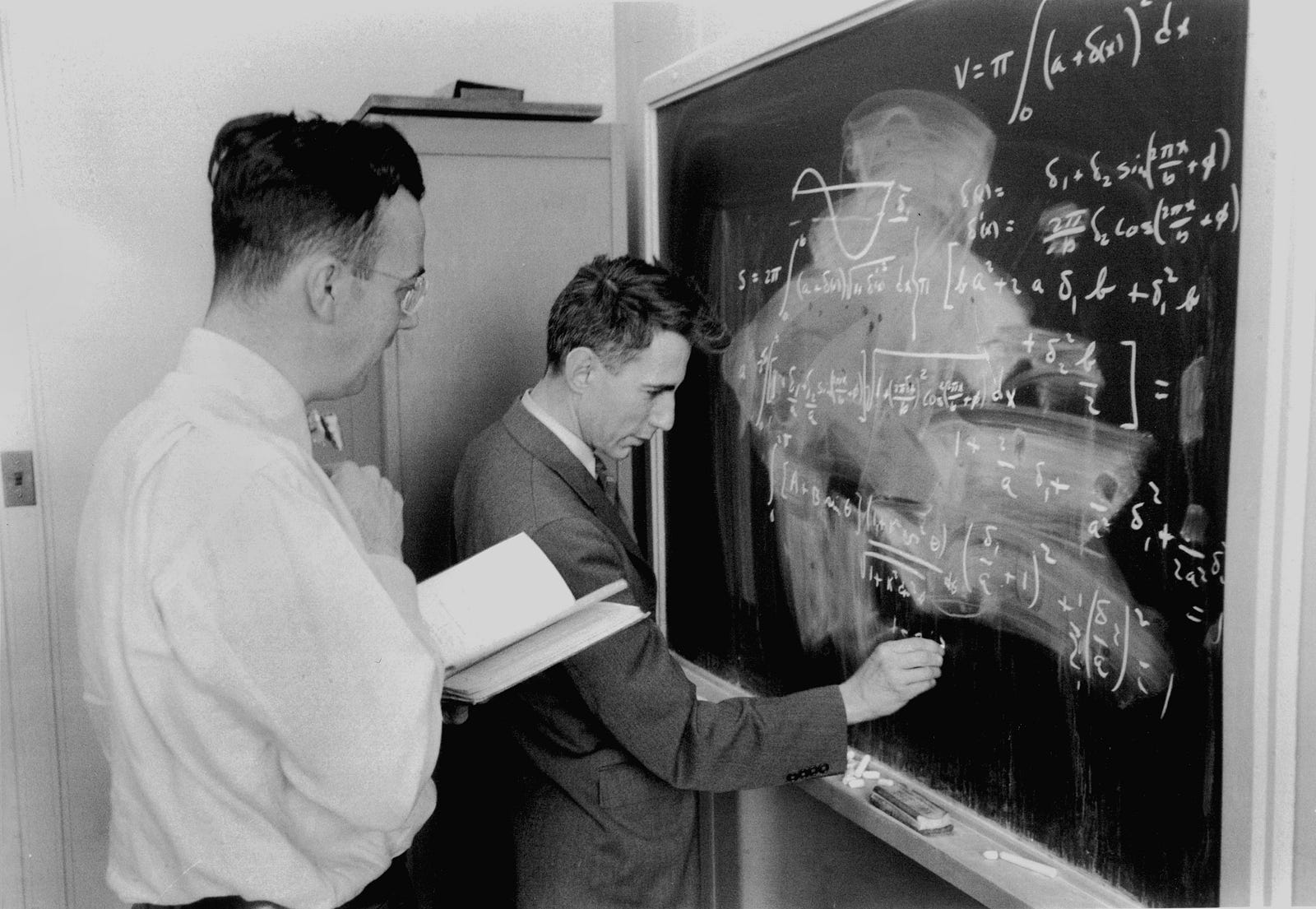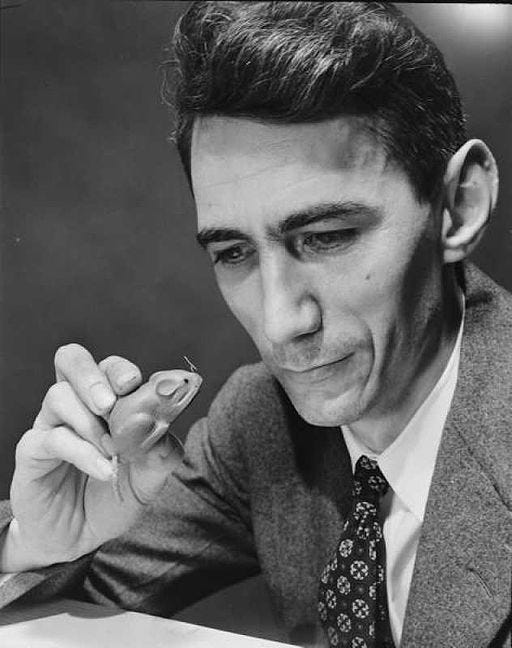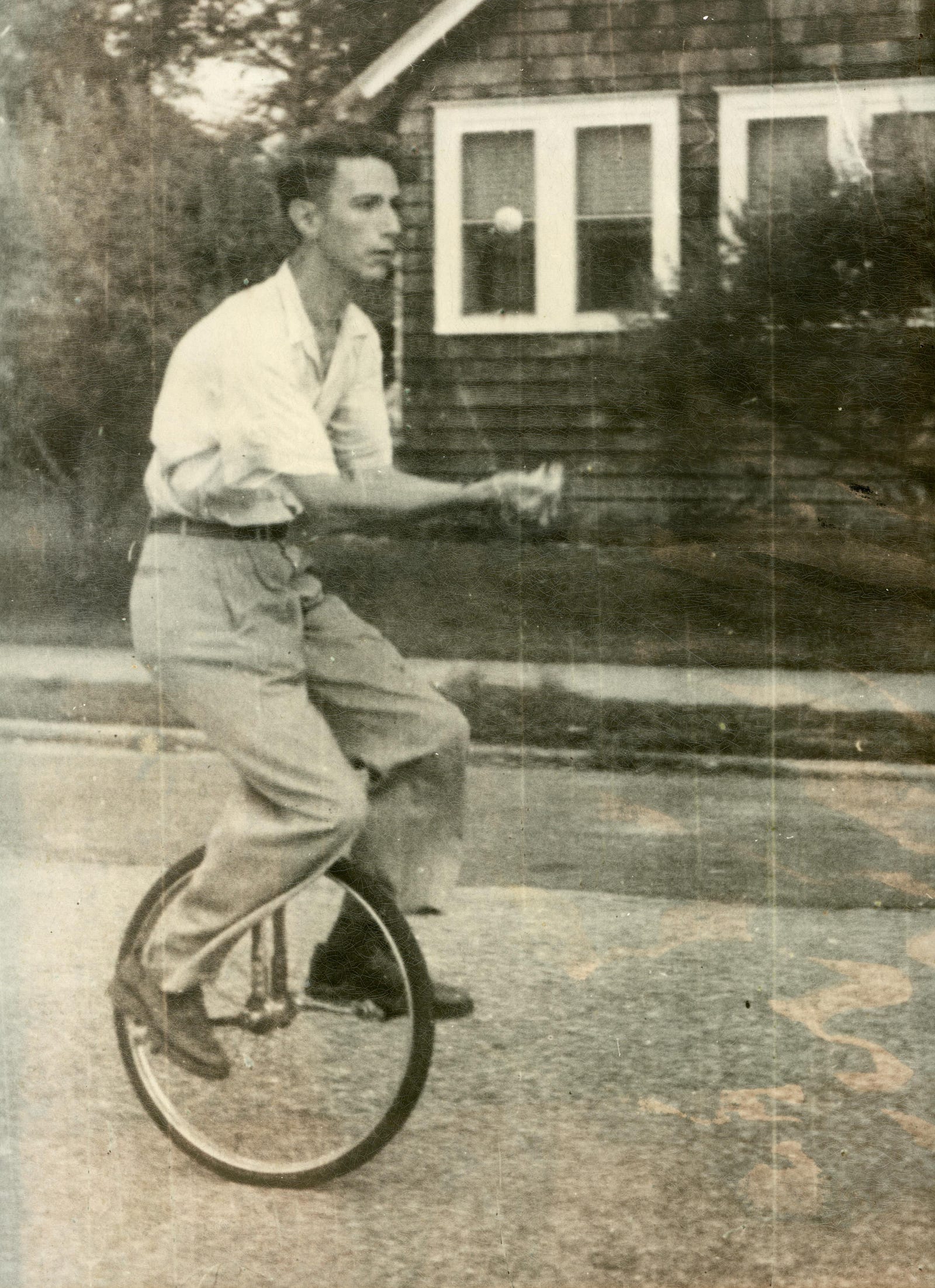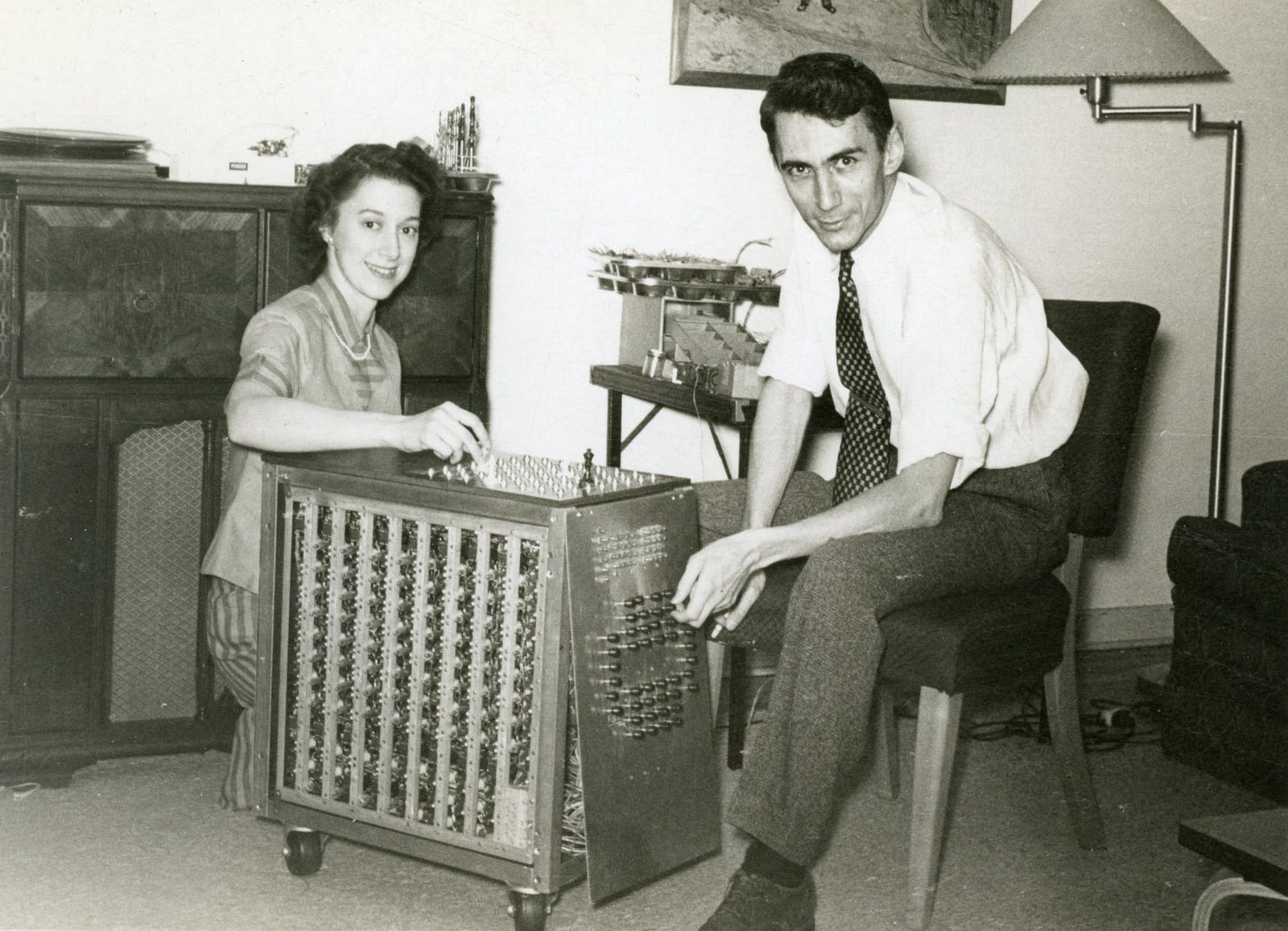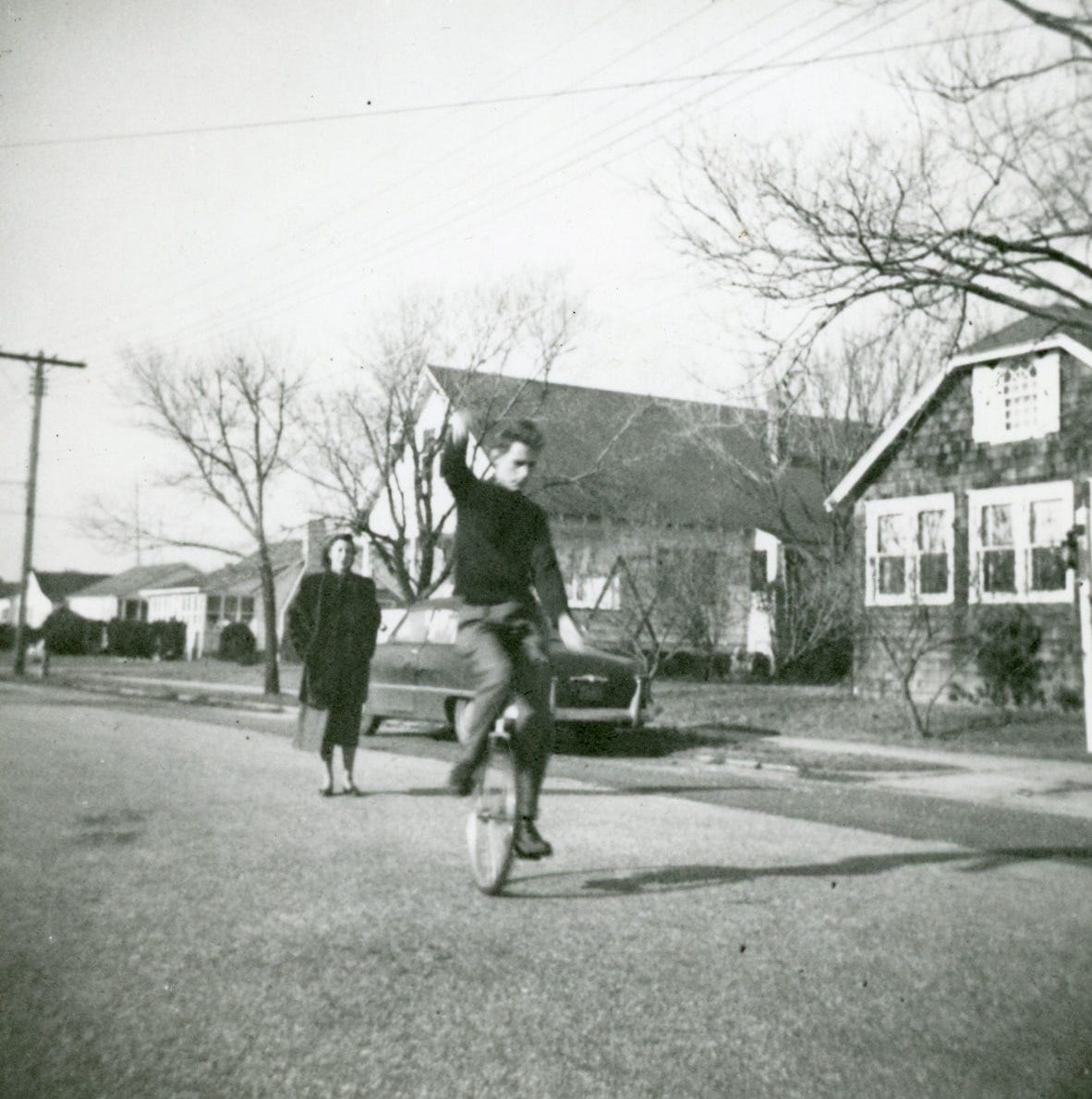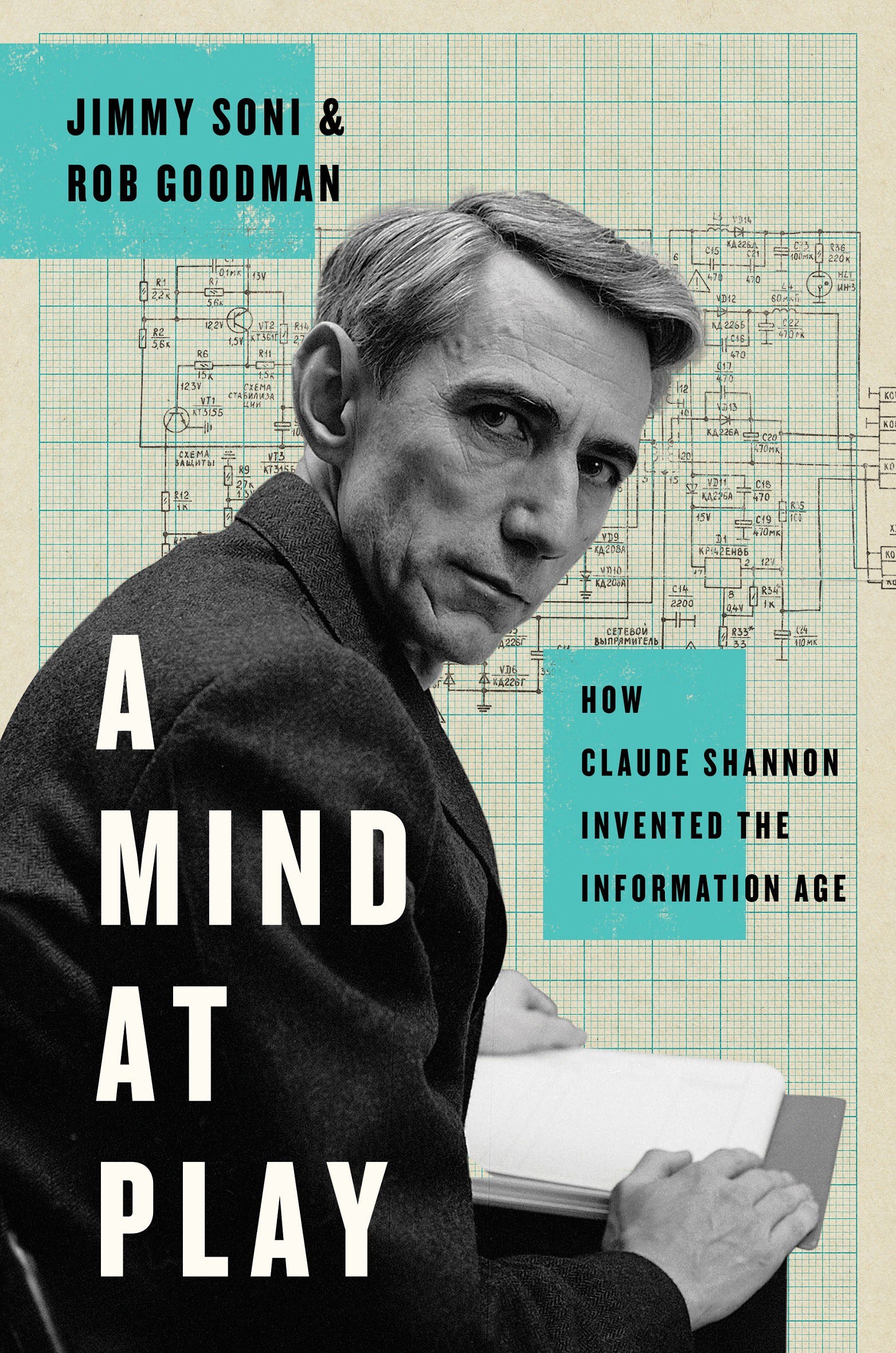10,000 Hours With Claude Shannon: How A Genius Thinks, Works, and Lives
We got up-close-and-personal with a genius for five years. Here are 12 things we learned.
By Rob Goodman and Jimmy Soni, co-authors, A MIND AT PLAY
For the last five years, we lived with one of the most brilliant people on the planet.
Sort of.
See, we just published the biography of Dr. Claude Shannon. He’s the most important genius you’ve never heard of, a man whose intellect was on par with Albert Einstein and Isaac Newton.
We spent five years with him. It’s not an exaggeration to say that, during that period, we spent more time with the deceased Claude Shannon than we have with many of our living friends. He became something like the roommate in the spare bedroom of our minds, the guy who was always hanging around and occupying our head space.
Yes, we were the ones telling his story, but in telling it, he affected us, too. Geniuses have a unique way of engaging with the world, and if you spend enough time examining their habits, you discover the behaviors behind their brilliance. Whether or not we intended it to, understanding Claude Shannon’s life gave us lessons on how to better live our own.
That’s what follows in this essay. It’s the good stuff our roommate left behind.
Claude, Who?
His name may not ring a bell. Don’t worry, we didn’t know who he was either when we started.
So who was he?
Within engineering and mathematics circles, Shannon is a revered figure. Claude Shannon’s work in the 1930s and 1940s earned him the title of “father of the information age.” At the age of 21, he published what’s been called the most important master’s thesis of all time, explaining how binary switches could do logic. It laid the foundation for all future digital computers.
He wasn’t done. At the age of 32, he published “A Mathematical Theory of Communication,” which has been called “the Magna Carta of the information age.” Shannon’s masterwork invented the bit, or the objective measurement of information, and explained how digital codes could allow us to compress and send any message with perfect accuracy.
But that’s not all he did.
Claude Shannon wasn’t just a brilliant theoretical mind — he was a remarkably fertile, fun, practical, and inventive one as well. There are plenty of mathematicians and engineers who write great papers. There are fewer of them who, like Shannon, are also jugglers, unicyclists, gadgeteers, first-rate chess players, codebreakers, expert stock-pickers, and amateur poets.
He worked on the top-secret transatlantic phone line connecting FDR and Winston Churchill during World War II and co-built what was arguably the world’s first wearable computer. He learned to fly airplanes and played the jazz clarinet. He rigged up a false wall in his house that could rotate with the press of a button, and he once built a gadget whose only purpose when it was turned on was to open up, release a mechanical hand, and turn itself off. Oh, and he once had a photo spread in Vogue magazine.
Think of him as a cross between Albert Einstein and the Dos Equis guy.
Asking the questions he probably wouldn’t
We aren’t mathematicians or engineers; we write books and speeches, not code. That meant we had a steep learning curve in making sense of his work.
But that was sort of the point: We had to learn everything from scratch and make it sensible on the page. Had we approached this book as experts, we might have been tempted to go deeper and deeper into the details of Shannon’s theorems, diagrams, and proofs.
But because we approached this book as learners, we were particularly interested in a broader, more generalist set of questions: how does a mind like Claude Shannon’s work? What shapes a mind like that? What does a mind like that do for fun? What can we take from it to be just a bit more brilliant in our own pursuits, whatever they happen to be?
Claude Shannon wasn’t especially interested in offering direct answers to questions like those. If he were alive to read this piece, he’d probably laugh at us. His mind was a heat-seeking missile targeting problems. What got him up in the morning was dissecting how things worked, not digressions into creativity and productivity.
No matter how many people came to him for advice, he never felt that he was in the advice-giving business. During his days as a professor, he was particularly nervous about the mentoring aspect of the job. “I can’t be an advisor,” he once protested. “I can’t give advice to anybody. I don’t have the right to advise.”
As usual, though, Shannon was being excessively modest. He can teach us a lot, even if he approached the whole business of teaching reluctantly and indirectly. To that end, we’ve distilled what we’ve learned from him over these last few years into this piece. It isn’t a comprehensive list by any means, but it does begin, we hope, to reveal what this unknown genius can teach the rest of us about thinking — and living.
12 Lessons Learned, Over Five Years, Writing One Book
1) Cull your inputs.
We all know how the constant distractions of social media and buzzing smartphones destroy focus and productivity. We also know that the problem is considerably more difficult than it was in mid-20th-century America (and yes, we suppose Claude Shannon bears some inadvertent blame for this).
But distractions are a permanent feature of life, in any era, and Shannon shows us that shutting them out isn’t just a matter of achieving random bursts of focus. It’s about consciously designing one’s life and work habits to minimize them.
For one, Shannon didn’t allow himself to get caught up in clearing out his inbox. Letters he didn’t want to respond to went into a bin labeled “Letters I’ve Procrastinated On For Too Long.” In fact, we pored over Shannon’s correspondence at the Library of Congress in Washington, DC, which keeps his papers on file — and we found far more incoming letters than outgoing ones. All of that time saved was more time to plow back into research and tinkering.
Inbox zero, be damned.
Shannon extended the same attitude to his time in the office, where his colleagues regularly expected to find his door closed (a rarity in Bell Labs’ generally open-door culture). None of Shannon’s colleagues, to our knowledge, remembered him as rude or unfriendly; but they do remember him as someone who valued his privacy and quiet time for thinking. One colleague remembered, “You would knock on the door and he would talk to you, but otherwise, he kept to himself.”
On the other hand, colleagues who came to Shannon with bold new ideas or fascinating engineering puzzles remembered hours of productive conversations. That’s just to say that Shannon, as in so much else, was deliberate about how he invested his time: in stimulating ideas, not in small talk. Even for those of us who are more extraverted than Shannon was (and, to be honest, that’s nearly all of us), there’s something to learn from how deliberately and consistently he turned his work hours into a distraction-free zone.
2) Big picture first. Details later.
In his mathematical work, Shannon had a quality of leaping right to the central insight and leaving the details to be filled in later. As he once explained it, “I think I’m more visual than symbolic. I try to get a feeling of what’s going on. Equations come later.” It was as if he saw solutions before he could explain why they were correct.
As his student Bob Gallager recalled, “He had a weird insight. He could see through things. He would say, ‘Something like this should be true’…and he was usually right…You can’t develop an entire field out of whole cloth if you don’t have superb intuition.”
Occasionally, this got Shannon in trouble — academic mathematicians sometimes accused him of being insufficiently rigorous in his work. Usually, though, their critiques were misguided. “In reality,” said the mathematician Solomon Golomb, “Shannon had almost unfailing instinct for what was actually true.” If the details of the journey needed filling in, the destination was almost always correct.
Most of us, of course, aren’t geniuses, and most of us don’t have Shannon-level intuition. So is there anything to learn from him here? We think there is: even if our intuitions don’t lead us to develop an entirely new field like information theory, they often have a wisdom that we can choose to tune into or to shut up.
Worrying about missing details and intermediate steps is a sure way to shut our intuitions up, and to miss out on some of our best shots at creative breakthroughs. Expecting our big ideas to unfold logically from premise to conclusion is a misunderstanding of the way creativity usually works in practice. As the writer Rita Mae Brown put it, “Intuition is a suspension of logic due to impatience.”
It’s one thing to clean up and fill in the details after the fact. It’s another thing to mistake the neat-and-tidy way we present our ideas to others, and others present their ideas to us — in an article, a slideshow, or a talk — for the messy process of getting to those ideas. Waiting for a neat-and-tidy breakthrough usually means waiting for a train that’s never arriving.
3) Don’t just find a mentor. Allow yourself to be mentored.
A lot of articles like this preach the value of mentorship, and we don’t want to belabor the point. Of course mentors matter. But a lot of writing about mentorship tends to treat a mentor as something you acquire: find the right smart, successful person to back your career, and you’re all set.
It’s not that simple. Making the most of mentorship doesn’t just require the confidence to approach someone whose guidance can make a difference in your development. It requires the humility to take that guidance to heart, even when it’s uncomfortable, challenging, or counterintuitive. Otherwise, what’s the point?
Shannon’s most pivotal mentor was probably his graduate school advisor at MIT, Vannevar Bush, who went on to coordinate the American scientific effort in WWII and became the first presidential science advisor. Bush recognized Shannon’s genius, but he also did what mentors are supposed to do — he pushed Shannon out of his comfort zone in some productive ways.
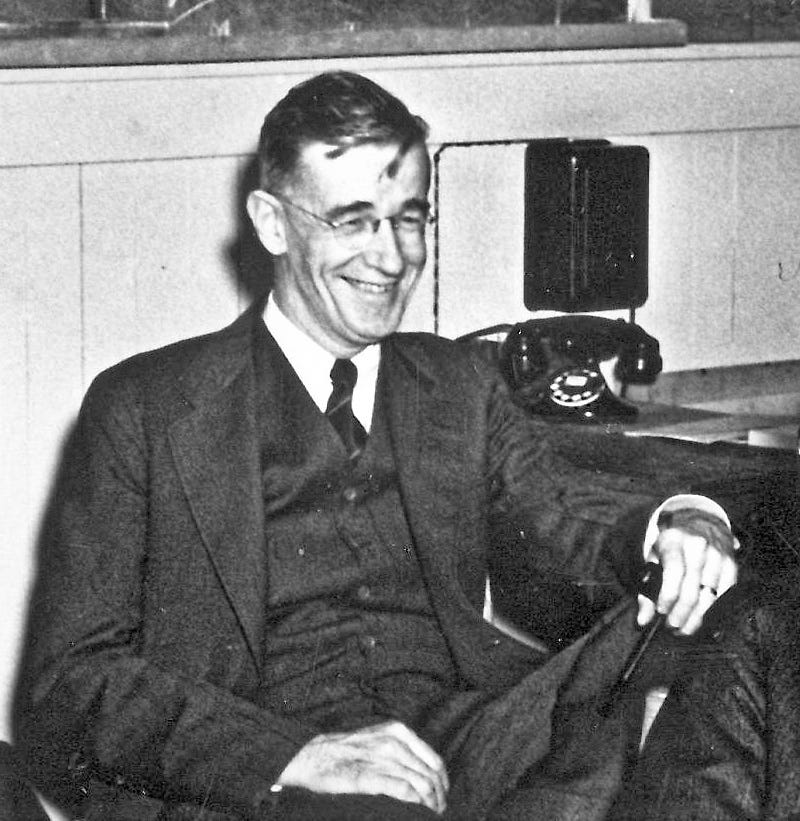
For instance, after the success of Shannon’s master’s thesis, Bush urged Shannon to write his PhD dissertation on theoretical genetics, a subject Shannon had to pick up from scratch and that was far afield from the engineering and mathematics he had spent years working on. That Bush pushed Shannon to do so testifies to his trust in his protege’s ability to rise to the challenge; that Shannon agrees testifies to his willingness to stretch himself.
There’s a whole set of possible responses Shannon might have had to that moment (“Genetics, huh?”). But Bush knew what he was doing, and Shannon was humble enough to trust his judgment and let himself be mentored.
Accepting real mentorship is, in part, an act of humility: The best of it comes when you’re actually willing to trust that mentor sees something you don’t see. There’s a reason, after all, that you sought them out in the first place. Be humble enough to listen.
4) You don’t have to ship everything you make.
Vannevar Bush left his imprint on Shannon in another way: he defended the value of generalizing over specializing. As he told a group of MIT professors:
“In these days, when there is a tendency to specialize so closely, it is well for us to be reminded that the possibilities of being at once broad and deep did not pass with Leonardo da Vinci or even Benjamin Franklin. Men of our profession — we teachers — are bound to be impressed with the tendency of youths of strikingly capable minds to become interested in one small corner of science and uninterested in the rest of the world. . . . It is unfortunate when a brilliant and creative mind insists upon living in a modern monastic cell.”
Bush encouraged Shannon to avoid cells of all kinds — and Shannon’s subsequent career proves how deeply he absorbed the lesson.
We know: Bush’s advice would probably sound unfashionable these days. So many of the pressures in our professional lives push us to specialize at all costs, to cultivate that one niche skill that sets us apart from the competition, and to keep hammering away at it. In this view, people whose interests are broad rather than deep are basically unserious. And what’s worse, they’re doomed to be overtaken by rivals who know how to really focus.
It’s a view that would have exasperated Shannon. Bush’s generalist gospel struck such a deep chord with him, we think, because it accorded with Shannon’s natural curiosity. He was so successful in his chosen fields not just because of his raw intellectual horsepower, but because of how deliberately he kept his interests diverse.
His remarkable master’s thesis combined his interests in Boolean logic and computer-building, two subjects that were considered entirely unrelated until they fused in Shannon’s brain. His information theory paper drew on his fascination with codebreaking, language, and literature. As he once explained to Bush:
“I’ve been working on three different ideas simultaneously, and strangely enough it seems a more productive method than sticking to one problem.”
And while he was diving into these intellectual pursuits, Shannon kept his mind agile by taking up an array of hobbies: jazz music, unicycling, juggling, chess, gadgeteering, amateur poetry, and more. He was a person who could have used his talents to burrow ever deeper and deeper into a chosen field, wringing out variations on the same theme for his entire career. But we’re fortunate that he chose to be a dabbler instead.
Part of dabbling is giving yourself the freedom to stop when you want to. Talented as he was, Shannon didn’t finish everything he started. While that might also run counter to a lot of modern advice on productivity, we think there’s real wisdom in it. Shannon would work until he felt satisfied — and then move on to other things. Where some people see a dilettante, we see a fertile mind that knew exactly how far to take a project before moving on.
Even the oracle of the modern productivity movement, Tim Ferriss, preaches the importance of knowing when to fold ’em: “Being able to quit things that don’t work is integral to being a winner.” There’s a reason so many great writers have an unpublished novel tucked away in the drawer. There’s a reason so many talented artists end up with a stockpile of unfinished paintings in their studios.
Not everything you make needs to ship. Some things you do for you.
5) Chaos is okay.
When he partnered with Shannon in 1961 to build a pioneering wearable computer to beat the house at roulette, Ed Thorp got to see Shannon’s work environment up close — in particular, the huge home workshop where Shannon did the bulk of his tinkering.
Here’s how Thorp described the workshop: it was “a gadgeteer’s paradise…There were hundreds of mechanical and electrical categories, such as motors, transistors, switches, pulleys, gears, condensers, transformers, and on and on.” Shannon had no qualms about getting his hands dirty, about leaving machine parts and half-finished projects scattered all over the place, of jumping from project to project as he followed his curiosity.
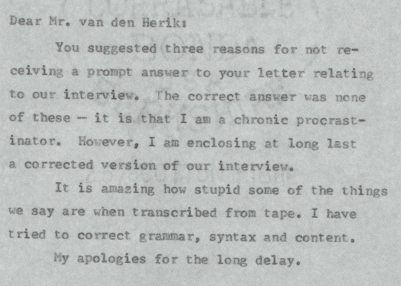
Shannon’s more academic pursuits resembled that workshop, too. His attic was stuffed with notes, half-finished articles, and “good questions” on ruled paper.
On one hand, we can regret the amount of unfinished work he never got around to sending out into the world. On the other, we can recognize that that chaos was the condition of the remarkable work he did do: rather than pouring mental energy into tidying up his papers and his workspace, Shannon poured it into investigating chess, robotics, or investment strategies. Call him an early adopter of The Joy of Leaving Your Shit All Over the Place.
6) Time is the soil in which great ideas grow.
Shannon’s breadth of interests meant that his insights sometimes took time to come to fruition. Often, unfortunately, he never got around to publishing his findings at all. But if his tendency to follow his curiosity wherever it led sometimes rendered him less productive, he also had the patience to keep coming back to his best ideas, over the course of years.
His 1948 information theory paper was nearly a decade in the making. He was just finishing grad school in 1939 when he first conceived the idea of studying “some of the fundamental properties of general systems for the transmission of intelligence, including telephony, radio, television, telegraphy, etc.” The years between the first inkling of the idea and its publication would take Shannon not only deeper into the study of information, but into work aiding America’s WWII effort, including research on anti-aircraft gunnery and cryptography. But Shannon’s information theory continued to germinate, even when he had to work on it in his free time.
Reflecting on this time later, he remembered the flashes of intuition. The work wasn’t linear; ideas came when they came. “These things sometimes…one night I remember I woke up in the middle of the night and I had an idea and I stayed up all night working on that.” When his information theory paper finally landed, observed one of Shannon’s colleagues, “it came as a bomb.” It was the sum of a decade’s disciplined thought, and Shannon’s willingness to let his ideas mature paid off.
This is probably the hardest lesson for us to swallow, living in the age that we do. We bathe in instant gratification. And the idea of waiting ten minutes, let alone ten years, for some reaction to our work can seem almost outlandish. But for people in the creative, entrepreneurial, and idea-making worlds, there may be no more useful advice we need to hear. Genius takes time.
Remember also: Claude Shannon wasn’t working on information theory full-time for ten years. It was, for many of those years, his side hustle. Maybe the ultimate side hustle. But his endurance in sticking with it yielded the most important work he’d ever produce.
What could we do in our spare time if we stuck with something for long enough?
7) Consider the content of your friendships.
Shannon kept limited company. The most one of his Bell Labs colleagues could say for Shannon’s social life was that he was “not unfriendly” — but he was certainly never the life of the party.
Another colleague, Brockway McMillan, observed that Shannon “had a certain type of impatience with the kind of mathematical argument that was fairly common. He addressed problems differently from the way most people did.” And Shannon’s different intellectual wavelength often gave him an air of aloofness or impatience; as McMillan put it, “He never argued his ideas. If people didn’t believe in them, he ignored those people.”
There’s a fine line between arrogance and serene self-confidence. Shannon generally stayed on the right side of the line, because he had the intellectual resources to back up his confidence. But just as importantly, he spent his time cultivating those resources, because he was never one to get caught up in jockeying for status, playing office politics, or trying to win over every critic. The pleasure of problem-solving was worth more to him than all of that, and so when it came to choosing his relatively small number of friends, he deliberately chose those who took pleasure in the same thing, and who helped to bring out the best in him.
During World War II, those friends included Alan Turing, with whom Shannon struck up a lively intellectual exchange during Turing’s fact-finding trip to study American cryptography on behalf of the British government. At Bell Labs, Shannon also bonded with fellow engineers Barney Oliver and John Pierce, each of whom was a pioneering figure in the history of information technology in his own right.
Shannon benefitted from the same process. He grew smarter and more creative because he chose to surround himself, almost exclusively, with people whose smarts and creativity he admired. More than most of us, he was deliberate in his friendships, only choosing friends who drew out his best.
Shannon’s approach to friendship focused on the content, not just the connection. Sure, Shannon and his friends had casual moments and their share of fun; but probably more than many friends, they also spent time talking about serious and heady things. Alan Turing and Claude Shannon didn’t bond by talking about the weather. They bonded by talking about artificial intelligence as only two of its pioneers could.
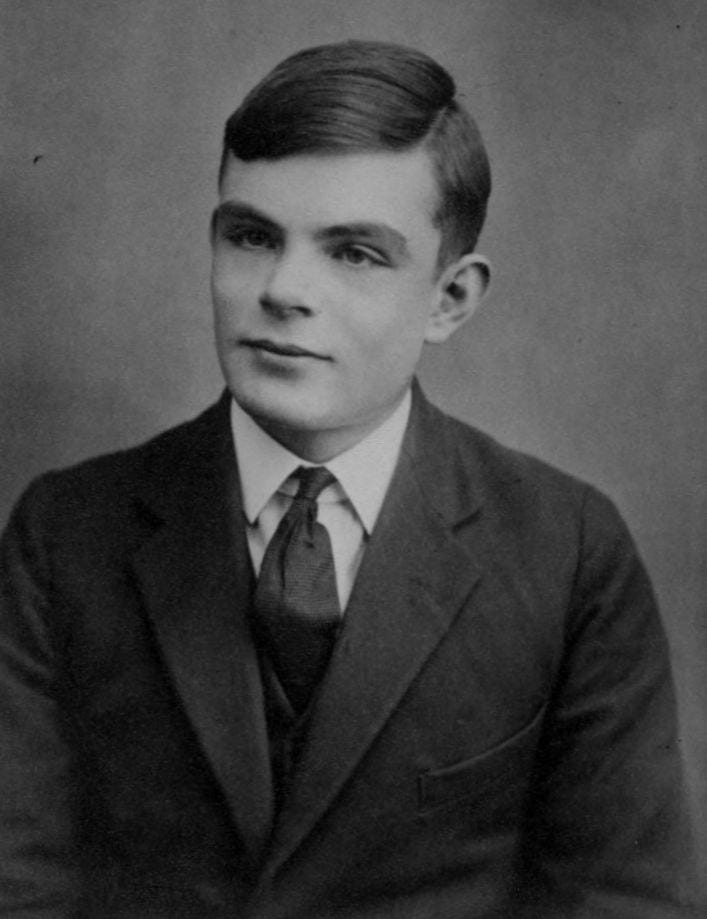
What does that mean for the rest of us non-geniuses? It doesn’t mean abandoning all of your friends and replacing them with new ones. It means asking yourself not just who your friends are but what you do together. Think more deliberately about the substance of your time with them, and if you find it lacking, change it.
8) Put money in its place.
Legend had it that Shannon’s office was overflowing with checks — royalties for his publications, or returns on his stock market investments — that he was too absentminded to cash. Like most legends, this was an exaggeration; but like many legends, it also grew from a grain of truth. One of Shannon’s colleagues did report seeing a large uncashed check on his desk, and a recurring theme in his friends’ recollections was his seeming indifference to money.
The accumulation of money was never one of Shannon’s central concerns. At the same time, he did accumulate money. He was a successful investor in early Silicon Valley companies, like Teledyne and Harrison Laboratories (which was acquired by Hewlett-Packard). Shannon pursued stock-picking as one of his many hobbies, gave talks on investing, and died a wealthy man.
So how did he square that with his almost single-minded pursuit of curiosity and scientific play?
There’s a great line from the stoic philosopher Seneca: “He is a great man who uses earthenware dishes as if they were silver; but he is equally great who uses silver as if it were earthenware. It is the sign of an unstable mind not to be able to endure riches.” As odd as it sounds that riches are something to be “endured,” Seneca has a point here: the pursuit of money is a powerful distraction from the pursuit of what truly matters. Money is neither the root of all evil nor the solution to all of our problems: the question is whether it gets in the way of what’s morally important.
Shannon is an excellent example of what it looks like to be wealthy without being consumed by the pursuit of wealth. He saw wealth not as an opportunity to live lavishly, but as an opportunity to spend more time on the gadgeteering projects he loved; his investment returns funded, for instance, his research into the physics of juggling and the construction of a juggling robot, as well as his invention with Ed Thorp of their roulette-beating wearable computer.
None of us need to be told that the pursuit of money can obscure what’s important and valuable. But it is useful to remind ourselves that wealth nearly always comes as an indirect effect of incredible work rather than as the end goal. The Silicon Valley entrepreneur Paul Graham puts it like this, “I get a lot of criticism for telling founders to focus first on making something great, instead of worrying about how to make money. And yet, that is exactly what Google did. And Apple, for that matter. You’d think examples like that would be enough to convince people.”
One more example can always help. In the end, the lesson of Shannon’s financial life isn’t just the indifference to money — it’s that he was both indifferent to it and managed to acquire it. We think the former freed up the brain space to work on the things that led to the latter. It’s an important insight for all of us.
9) Fancy is easy. Simple is hard.
Shannon wasn’t impressed by his colleagues who wrote the most detailed tomes, or whose theories came with the most bells and whistles. What impressed him the most — in a way that reminds us of Steve Jobs — was radical simplicity.
In a 1952 talk to his fellow Bell Labs engineers, Shannon offered a crash course in the problem-solving strategies that had proven most productive for him. At the top of the list: you should first approach your problem by simplifying. “Almost every problem that you come across is befuddled with all kinds of extraneous data of one sort or another,” Shannon said, “and if you can bring this problem down into the main issues, you can see more clearly what you’re trying to do.”
Simplification is an art form: it requires a knack for excising everything from a problem except what makes it interesting. Shannon admitted that this process could file a problem down to almost nothing — but that was precisely the point: “Very often if you can solve this simple problem, you can add refinements to the solution of this until you get back to the solution of the one you started with.”
Dr. Bob Gallager, a Shannon graduate student who went on to become a leading information theorist himself, saw this process of radical simplification in action. He describes coming to Shannon’s office one day with a new research idea full of “bells and whistles.” For Shannon, though, those were just a distraction:
He looked at it, sort of puzzled, and said, ‘Well, do you really need this assumption?’ And I said, well, I suppose we could look at the problem without that assumption. And we went on for a while. And then he said, again, ‘Do you need this other assumption?’…And he kept doing this, about five or six times….At a certain point, I was getting upset, because I saw this neat research problem of mine had become almost trivial. But at a certain point, with all these pieces stripped out, we both saw how to solve it. And then we gradually put all these little assumptions back in and then, suddenly, we saw the solution to the whole problem. And that was just the way he worked.
A lot of us are trained to think that our ability to grapple with ever-more-complex concepts is the measure of our intelligence. The more complicated the problem, the smarter the person needed to solve it, right? Maybe. Shannon helps us see how the opposite might be true, too. Achieving simplicity may actually be the more intellectually demanding endeavor.
After all, as Ben Casnocha, the author (and the inspiration for this essay), wrote, “Making the complex simple does not mean ignoring the complexity.” That was true of Shannon: He could do high-level mathematics with the best of them, but he’s remembered today because he could boil things down, not build them up.
Never confuse simplicity with simple-mindedness. It takes work to distill, to get at the essence of things, to be brief. If you stop yourself from saying something in a meeting because you’ve just thought, “Well, that’s just too simple,” you might want to think again. It may be that it’s the very thing that needs to be said.
10) The less marketing you need, the better your idea or product probably is.
By his early thirties, Shannon was one of the brightest stars of American science, with the media attention and prestigious awards to prove it. His “information theory” had caught on — and he was regularly touted as one of the most brilliant minds in his generation of scientists.

Yet, at the height of his brief fame, when his information theory had become the buzz-phrase to explain everything from geology to politics to music, Shannon published a four-paragraph article kindly urging the rest of the world to vacate his “bandwagon.”
As he put it, “[Information theory] has perhaps been ballooned to an importance beyond its actual accomplishments. Our fellow scientists in many different fields, attracted by the fanfare and by the new avenues opened to scientific analysis, are using these ideas in their own problems…In short, information theory is currently partaking of a somewhat heady draught of general popularity.”
In place of that popularity, which he admitted could feel “pleasant and exciting,” he advised his fellow engineers and mathematicians to focus on research. “The subject of information theory has certainly been sold, if not oversold. We should now turn our attention to the business of research and development at the highest scientific plane we can maintain,” he said.
It wasn’t because he wanted the turf for himself. For Shannon, useful, informed applications of information theory were always welcome. But there was real danger that the ideas he had set in motion might become stretched beyond their meaning.
The statement sent something of a shockwave through the scientific community. It was a remarkable set of words from someone who still had a full career ahead of him; someone who, in a practical sense, had every incentive to encourage information theory’s inflation. But what mattered to him was the truth — and it was his commitment to sincere, serious research that ultimately made his reputation.
Put differently: Shannon didn’t aggressively market his ideas, and we think he would have found it gauche to do so. But he also didn’t have to, because his ideas were so striking and original that they caught fire on their own.
What does that mean for the rest of us? Don’t we all believe that our work is striking and original? Probably. And look, maybe our ideas are just that good. But Shannon’s example, and the surprising speed with which his ideas took off, can be valuable not when our ideas are that good, but when we veer to the opposite extreme: flogging our ideas well past the point at which we should know better. Sometimes there just isn’t a there there, and it’s time to move on.
Or, as the great philosopher Regina George put it in Mean Girls, “Stop trying to make ‘fetch’ happen! It just isn’t going to happen!”
11) Value freedom over status.
Reflecting on the arc of his career, Shannon confessed, “I don’t think I was ever motivated by the notion of winning prizes, although I have a couple of dozen of them in the other room. I was more motivated by curiosity. Never by the desire for financial gain. I just wondered how things were put together. Or what laws or rules govern a situation, or if there are theorems about what one can’t or can do. Mainly because I wanted to know myself.”
He wasn’t exaggerating. Shannon was regularly given awards that he wouldn’t go to the trouble of accepting. Envelopes inviting him to give prestigious lectures would arrive; he’d toss them into the “Procrastination” bin we mentioned earlier.
His indifference was on display for all to see in other ways: he accumulated so many honorary degrees that he hung the doctoral hoods from a device that resembled a rotating tie rack (which he built with his own hands). Whether the awarding institutions would have found that treatment fitting or insulting, it speaks to the lightness with which Shannon took the work of being lauded.
There were, of course, certain strategic and personal advantages to being immune to the pull of trophies and plaques. For Shannon, it gave him the ability to explore areas of research that no other “respectable” scientist might have ventured into: toy robots, chess, juggling, unicycles. He built machines that juggled balls and a trumpet that could breathe fire when it was played.
Mathematicians worry about spending time on problems of insufficient difficulty, what they dismissively call “toy problems”; Claude Shannon worked with actual toys in public! Time and again, he pursued projects that might have caused others embarrassment, engaged questions that seemed trivial or minor, then managed to wring the breakthroughs out of them.
Would he have been able to do all of that while chasing a Nobel or lusting after a National Medal? Possibly. But the fact that he didn’t give much thought to those external achievements allowed him to devote far more thought to the work itself.
We admit: It’s easier to write those words than to live by them. We’re all conscious of our status, and for the ambitious and talented, it’s especially tough to be indifferent to it. Shannon can help us break that hold, though, because his example points us to the rich prize on the other side of indifference: fun and freedom.
Set next to achievement, “fun” can sound too casual and unimportant, especially for a lot of type-A hard-chargers. But freedom is a more interesting and useful virtue. Even when it risked his status, Shannon pointedly did not stay in his lane. He gave himself the freedom to explore whichever discipline caught his fancy, and that freedom came, in part, from not caring what other people thought of him.
When we’re in the midst of chasing awards and honors, we often forget the way they can crowd out freedom. Nothing weighs you down like too many pieces of flair.
12) Don’t look for inspiration. Look for irritation.
How many of us, in search of a breakthrough like Claude Shannon’s, sit around waiting for inspiration to strike? That’s the wrong way to go about it.
One of the people who explained this the most trenchantly was the famous painter Chuck Close. As he put it, “Inspiration is for amateurs — the rest of us just show up and get to work. And the belief that things will grow out of the activity itself and that you will — through work — bump into other possibilities and kick open other doors that you would never have dreamt of if you were just sitting around looking for a great ‘art idea.’…If you hang in there, you will get somewhere.”
Shannon believed something quite similar when it came to looking for a great “science idea.” The idea might come from a good conversation, or tinkering in the workshop, or from the kind of aimless play he indulged in for much of his life — but above all, it came from doing, not waiting.
As Shannon told his fellow Bell Labs engineers, the defining mark of a great scientific mind is not some ethereal capacity for inspiration, but rather a quality of “motivation…some kind of desire to find out the answer, the desire to find out what makes things tick.” That fundamental drive was indispensable: “If you don’t have that, you may have all the training and intelligence in the world, [but] you don’t have the questions and you won’t just find the answers.”
Where does that fundamental drive come from? Shannon’s most evocative formulation of that elusive quality put it like this: it was “a slight irritation when things don’t look quite right,” or a “constructive dissatisfaction.” In the end, Shannon’s account of genius was a refreshingly unsentimental one: A genius is simply someone who is usefully irritated. And that useful irritation doesn’t come until, somewhere in the midst of the work, you stumble onto something that troubles you, pulls at you, doesn’t look quite right.
Don’t run away from those moments. Hold on to them at all costs
The people who spent time with Claude Shannon in the flesh felt lucky to have known him. We didn’t have that good fortune, but we do feel fortunate to have known him even at a remove. There are many people who helped us do that, and all of you know who you are. Thanks for putting up with us these last few years.
A final thought: The internet, the digital age, the technologies that underlie it all — these are remarkable human achievements. But we can too easily forget what their origins are, how and why they are here, where they sit in the flow of our history, and what kinds of men and women brought them about. We think there is something important in beginning to learn these things.
And that learning isn’t just about understanding the substance of what’s been built. It’s about understanding the spirit in which it was built, too. So many of the great sparks of innovation that made our world possible grew from the spirit of curiosity and creativity. They came from minds that, like Claude Shannon’s, saw their work as a game.
We think that’s a spirit worth remembering. More than that, we think it’s one worth living by.

